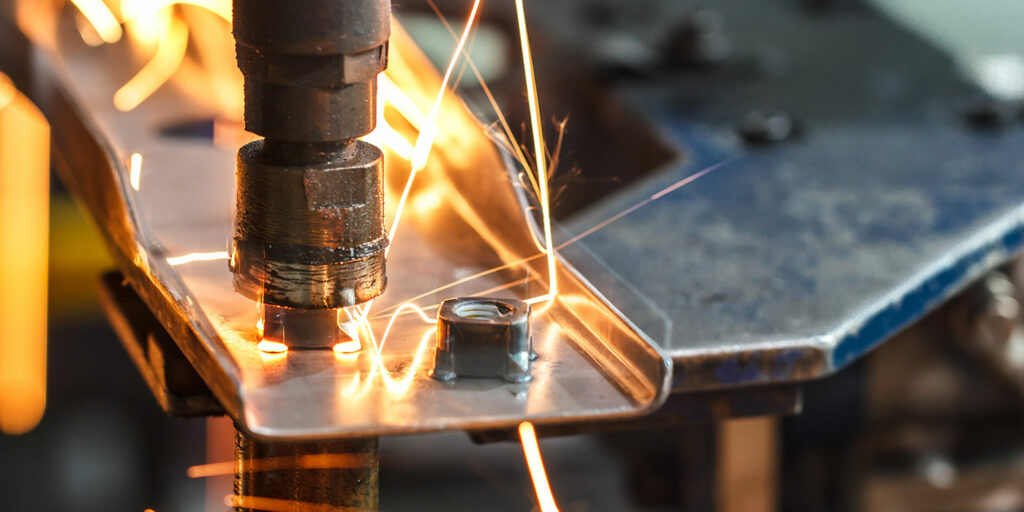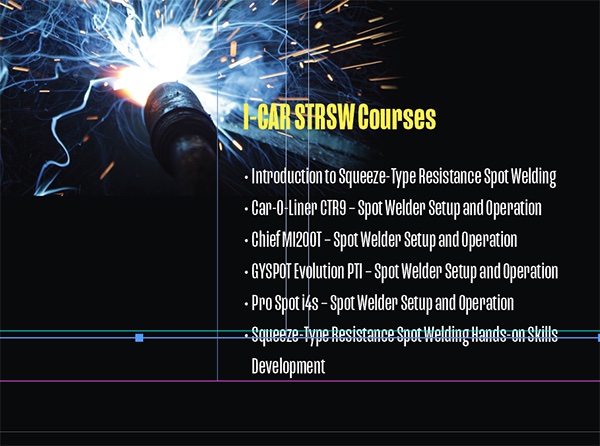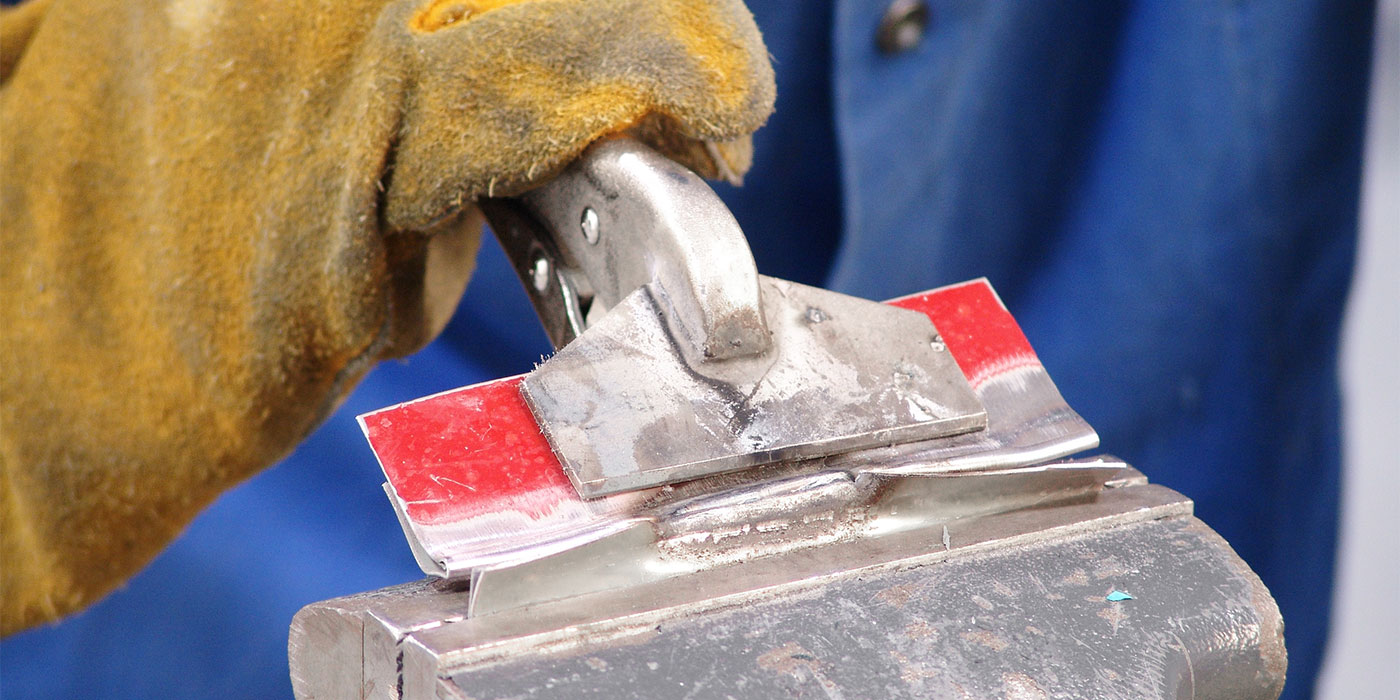Understanding why STRSW is becoming the preferred/required attachment method of OEMs is imperative to help ensure a complete, safe and quality repair.
Today’s vehicles are designed to perform a certain way during an impact. When you hear the word “impact,” what image does that put in your mind? Is it of a vehicle striking something or being struck by something? That is what most people typically think of. However, that is only one part of it.
In a vehicle collision, there are actually three impacts that occur:
- The vehicle impacting with an object
- The occupants impacting with the restraint devices
- The occupants’ internal organs impacting with bone or each other and rearranging
Vehicle makers are challenged to build safer cars that better protect the occupants from these three impacts. Building a stronger passenger compartment or cabin to reduce intrusion is essential, but manufacturers must also ensure that materials used in vehicle construction will minimize the forces experienced during the third impact.
Occupant Safety
Like any good sports team, there is a group effort to achieve the goal of occupant safety. There is no one aspect of the vehicle that accomplishes this alone. It is the complete package, designed to work together, that keeps the occupants safe in a collision.
Airbags and other restraints are designed to complement the collision management of the vehicle. The structure does its job not only to absorb as much energy as possible when parts are deforming (it takes energy to bend metal) but, at the same time, route energy around the cabin so there is minimal deformation and intrusion into the occupant’s space.
Airbag deployment timing is a critical factor for the airbags and seatbelt tensioners to do their job properly. If the ability to absorb or route energy is changed during a repair, the timing of the airbag deployment may be changed as well. Worse, it could lead to no deployment at all.
OEM body repair procedures are written the way they are for reason. Much time, effort and testing are involved to make sure that a repair will not only look good and last the life of the vehicle, but also maintain the same standard in a collision as it did when it left the factory, thus preserving the ability to reduce cabin intrusion and minimizing the force of the third impact. Think about that the next time you’re looking to deviate from an OEM procedure.
STRSW is far less prone to incorrect setup and human error when performing the weld.
When performing collision repairs, there are various attachment methods that may be identified in the repair procedures. These can vary between OEMs and even within vehicle models, but the two most common methods are plug welding and squeeze-type resistance spot welding (STRSW). Although some OEMs allow the use of plug welds to replace factory spot welds, the repair procedures may specify that STRSW is the preferred welding method. To help you understand why, let’s take a look at the differences between plug welding and STRSW.
Plug Welding
Plug welding is typically performed with a wire feed GMA (MAG) welder. It is a process that requires specific diameter holes to be punched or drilled at a specified distance apart, and then each weld must be performed by hand. Due to the nature of how the weld is created and the machine used to make it, this can lead to inconsistent and weak welds. A successful plug weld relies heavily on the experience of the person setting up the machine, and subsequently, performing the weld correctly. There are many variables in creating a plug weld – enough that even a seasoned welder’s confidence in the outcome of these welds can be reduced, especially on unfamiliar materials such as high-strength steels (HSS).
STRSW
STRSW is performed with a welder purpose-built for one thing. However, many spot welders have other attachments that permit additional functions. Although there are settings that need to be adjusted and sometimes specific welding tips are required, STRSW is far less prone to incorrect setup and human error when performing the weld. The ease of setup and the reduced ability for human error will produce more consistent and predictable welds. This, in turn, will increase the confidence in the outcome of the welds regardless of the type of steel being joined.
Despite the simplicity of STSRW, don’t be tricked into thinking it is foolproof.
Many OEMs that require or recommend STRSW will have specific spot welders approved for their vehicles. This information can usually be found in the vehicle-specific body repair manuals (BRMs) under general welding information or in the repair procedures or equipment lists. In addition, the welding information typically will include information such as current setting, cycles or time, and what tips to use. This is valuable information to have as the overall purpose of an OEM recommending or requiring STRSW is to most accurately replicate the factory spot welds that were removed during the repair process.
While replacing spot welds with spot welds will certainly recreate the factory look after a repair, the trend of OEMs moving toward STRSW over plug welds goes beyond just aesthetics. Being able to use an attachment method that closely replicates the OEM method helps to maintain the standard of vehicle integrity. A lot of the reason for the use of STRSW has to do with the vehicle construction.
Evolving Materials
The materials used in modern vehicles continue to evolve. We’ve all witnessed the decline in mild steel and the increase in HSS. Various strengths of HSS and ultra-high-strength steel (UHSS) are becoming more commonplace. Thinner, stronger types of steel continue to be developed and will see their way into the vehicles of tomorrow.
As stated above, these higher strength steels play a key role in OEMs recommending or requiring spot welds for collision repairs. STRSW creates a much smaller heat affect zone than plug welds. This is important as many higher strength steels are limited to the amount of heat that can be applied to them.
When spot welding is used during repairs, UHSS may not weld the same as mild steel. The welder will almost inevitably need a different setting for UHSS to make a proper weld. The vehicle maker may also have requirements for specific spot welding machines that may have preset programs for specific applications. Some spot welders may only need the sheet thickness and the type of material to be input and the welder will make the necessary adjustments.
When performing STRSW, here are few things to keep in mind:
- Most UHSS parts are typically replaced using STRSW welds at a factory seam and GMA (MAG) plug welds used to attach the part where a spot welder cannot reach.
- Some vehicle makers like Honda and Acura have specific guidelines and restrictions when welding on 1,500 MPa steel.
- With spot welding equipment, check and make sure that the welder is receiving the correct voltage at the receptacle. This is extremely important because if the voltage is too low, it will not make a good weld.
Verification is Key
Despite the simplicity of STSRW, don’t be tricked into thinking it is foolproof. Verifying that the welder is set to the correct settings for not only the vehicle you’re repairing but also the procedure you’re performing is essential. Additional layers or thicker materials often require different welder setting than fewer layers or thinner material. Again, this should be spelled out in the BRM.
In addition, OEMs typically recommend or require that destructive tests be performed on test pieces of the same type and thickness of material being welded. Illustrations or an explanation of what a successful weld will look like after the destructive test are typically given. It is important to verify that the destructive test performs as the BRM states it should.
Practice spot welds should be made, visually inspected and destructively tested before any welds are made on the vehicle to make sure the welder is set up and functioning properly. When making welds on HSS to UHSS, there may not be a tear-out of the weld nugget. When making welds on mild steel to UHSS, or high-strength low alloy (HSLA) steel to UHSS, there should be tear-out of the weld nugget of the weaker steel. If there is tear-out of the UHSS, the heat from the STRSW has changed the strength of the metal.
When performing repairs on a vehicle, here are a few questions to ask yourself:
- Will the vehicle perform as designed if it is put to the ultimate test (a major collision)?
- Would you put your loved ones in that vehicle after you or your staff repaired it?
- Will your welds hold up, and have you introduced undesirable compromises that may not be realized until the ultimate test?
- If your customer tests your work in the real world, will the outcome be favorable?
Summary
Understanding why STRSW is becoming the preferred or required attachment method by OEMs is imperative to help ensure a complete, safe and quality repair that maintains vehicle integrity to protect the occupants from the three impacts of a collision.















